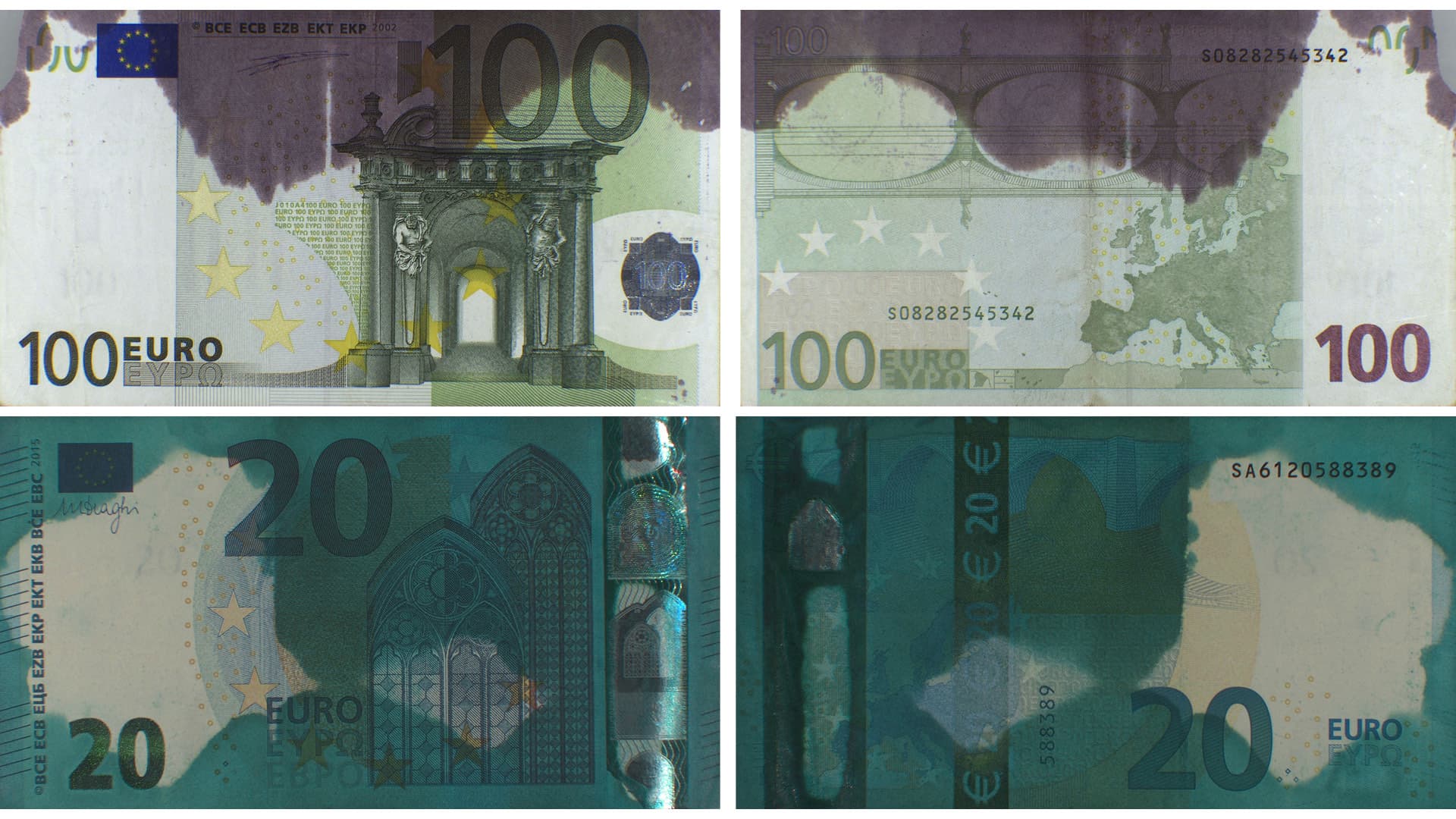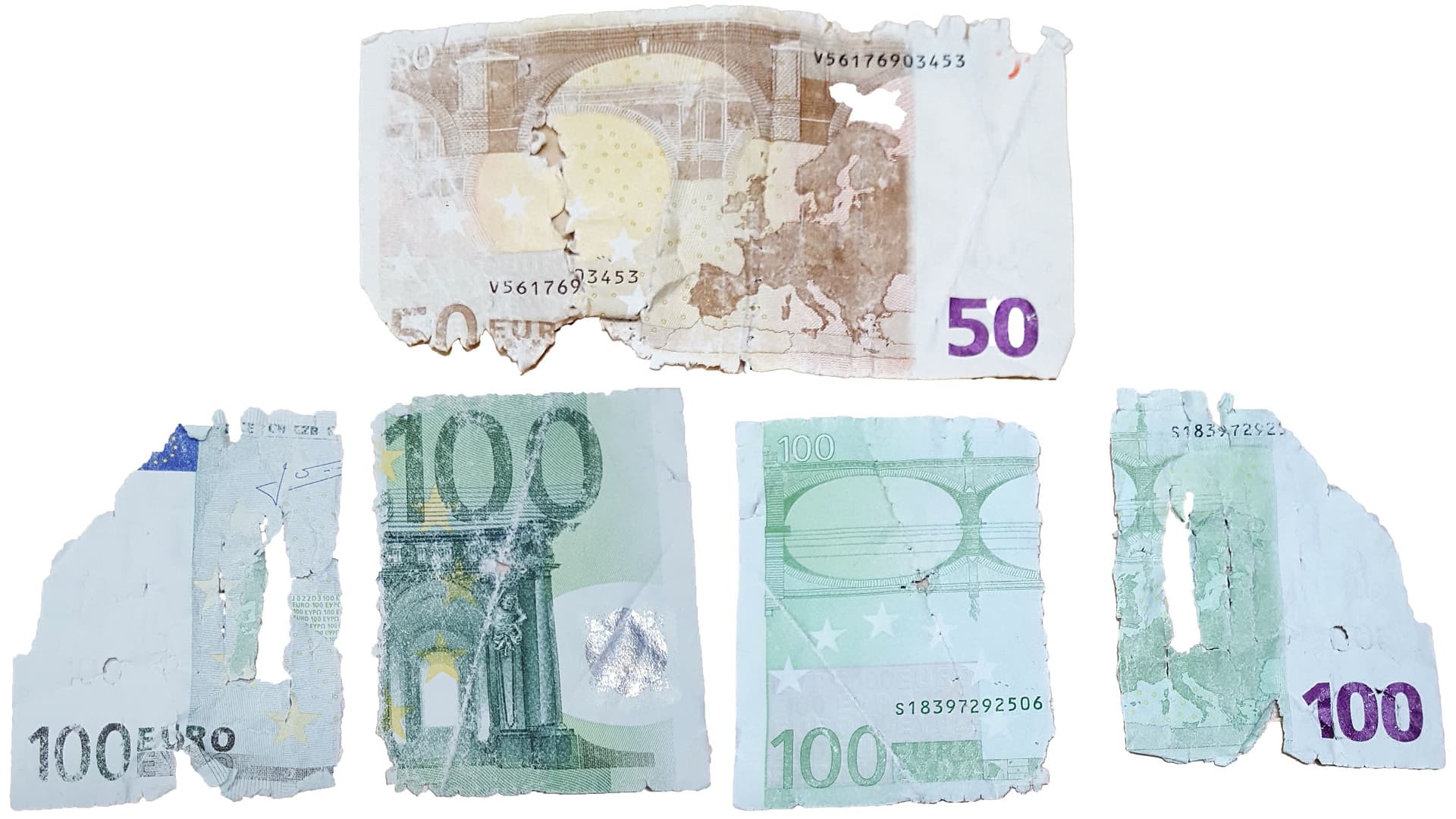From 1 January 2023, the Croatian National Bank replaces stained euro banknotes and the applicant has the obligation to enclose a written explanation of the type of the stain, contamination or impregnation with the application for replacement.
Where stained genuine euro banknotes result from the activation of an anti-theft electrochemical protection system, the applicant is required to enclose a written statement on the cause of the activation of electrochemical protection with the application and describe in detail how the staining occurred.
Where the genuine euro banknotes have been damaged by the activation of an anti-theft electrochemical protection system in connection with an attempted or actual robbery, theft, or other criminal activity, the banknotes are exchanged only at the request of the owner or otherwise authorised applicant who is the victim of the attempted or actual criminal activity leading to the damage to the banknotes.
Have you ever received a stained banknote?
Do not accept stained euro banknotes that look like the banknotes in Figure 1 below because there is a high probability that they are stolen and stained by the activation of the anti-theft electrochemical protection system.
Figure 1 Euro banknotes stained by ink from the anti-theft electrochemical protection system (Source: CNB.)


The ink on such banknotes originates from anti-theft electrochemical protection systems, which are activated to permanently label and destroy the banknotes when forcefully handled in an attempt to open them. These systems make stolen euro banknotes unfit for circulation, thus reducing the risk for retailers of accepting them as fit for circulation and thus becoming victims of crime.
Glued banknotes
In addition to staining, banknotes inside a monetary institution’s ATMs and during distribution can also be protected using other tools, such as the electrochemical protection system that destroys the banknotes with glue instead of ink. By activating such a system, glue fuses the banknotes into a solid brick so that they cannot be separated without being destroyed.
How to recognise euro banknotes stained by the electrochemical protection system?
A banknote stained by the activation of the electrochemical protection system soaks in the ink. Stains are usually more pronounced on the edges of the banknote. The colours of the most commonly used security inks are violet, green, blue, red or black. The ink usually flows from the edges towards the centre of the banknotes.
Sometimes, individuals try to remove the ink by washing the stained banknotes. As a result, the euro banknotes’ original colours could be altered and the banknotes’ security features may be damaged or even destroyed. Often the hologram is also removed from the banknote when it is exposed to a specific solvent.
Figure 2 A euro banknote damaged by washing at a high temperature (Source: CNB.)

Does it mean that all stained euro banknotes are stolen?
No, it does not. If there are very light stains on the euro banknotes or only a part of the banknotes’ surface is stained and the edges are intact, then they are most likely ink-stained accidentally or while being washed in a washing machine, etc. Such banknotes have probably not been stolen. However, irrespective of the type of the stain on the banknotes, they should be sent for analysis and replacement to the Croatian National Bank, with the attached Application for the analysis and replacement of stained banknotes.
Figure 3 A banknote washed and stained in a washing machine (Source: CNB.)

It is possible that in cash transactions someone will give you an ink-stained euro banknote. What to do in such a situation?
- Do not accept it and ask for another one.
- Refuse banknotes with visible traces of the staining because it has most likely been bleached or washed in an attempt to remove the stains caused by the ink from an anti-theft device.
- If you have come into possession of a stained euro banknote, send it to the Croatian National Bank with the attached Application for the analysis and replacement of stained banknotes, in which you should provide any information known to you.
- The Croatian National Bank can replace the euro banknotes stained by the ink from an anti-theft device only at the request of the legal owner of a stained banknote, with attached documents that can prove the cause of the activation of electrochemical protection.
- If the analysis confirms that the stains are not caused by the activation of an anti-theft device, the Croatian National Bank will replace the stained euro banknote.
Additional information in relation to the replacement of stained euro banknotes
From 1 January 2023, the Croatian National Bank, upon request, exchanges damaged genuine euro banknotes, in accordance with Art. 3 of the Decision of the European Central Bank of 19 April 2013 on the denominations, specifications, reproduction, exchange and withdrawal of euro banknotes (2013/211/EU) as last amended by Decision (EU) 2019/669 of the ECB of 4 April 2019 and Decision (EU) 2020/2090 of the ECB of 4 December 2020.
Where the genuine euro banknotes have been damaged by anti-theft devices and they are presented by institutions and economic agents referred to in Article 6, paragraph (1) of Regulation (EC) No 1338/2001, those institutions and economic agents are required to provide a written statement on the cause of activation, the reference and characteristics of the anti-theft device, details of the party presenting the damaged banknotes for the exchange and the date of their presentation.
Where institutions and economic agents referred to in Article 6, paragraph (1) of Regulation (EC) No 1338/2001 present for exchange, in one or more transactions, damaged genuine euro banknotes with a value of at least EUR 10 000, those institutions and economic agents are required to provide documentation on the origin of the banknotes and identification of the customer or, where applicable, of the beneficial owner as defined in Directive (EU) 2015/849 of the European Parliament and of the Council. This obligation also applies in the event of doubt regarding whether the threshold value of EUR 10 000 is reached.
Notwithstanding the above, where the Croatian National Bank knows or has sufficient reason to believe that the genuine euro banknotes have been intentionally damaged, it may refuse to exchange and may withhold the euro banknotes, in order to avoid the return of such euro banknotes into circulation or to prevent the applicant from presenting them to another euro area national central bank for exchange. Euro banknotes which are damaged to a minor degree, e.g. by having annotations, numbers or brief sentences placed on them, will in principle not be considered to be intentionally damaged euro banknotes.
Where the Croatian National Bank knows or has sufficient reason to believe that a criminal offence has been committed it refuses to exchange the damaged genuine euro banknotes and withholds them, against acknowledgement of receipt, as evidence to be presented to the competent authorities to initiate or to support an ongoing criminal investigation. Unless otherwise decided by the competent authorities, the genuine euro banknotes at the end of the investigation may qualify for exchange under the conditions laid down in Article 3, paragraphs (1) and (2) of the above Decision.
Where the Croatian National Bank knows or has sufficient reason to believe that the damaged genuine euro banknotes are contaminated such that they pose a risk to health and safety, it only receives the damaged genuine euro banknotes to be exchanged, if the applicant can provide a health and safety assessment by the competent authorities.
